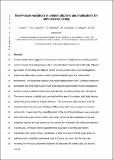Files in this item
Non-Poisson variations in photomultipliers and implications for luminescence dating
Item metadata
| dc.contributor.author | Carter, John | |
| dc.contributor.author | Cresswell, Alan | |
| dc.contributor.author | Kinnaird, Timothy Charles | |
| dc.contributor.author | Carmichael, Lorna | |
| dc.contributor.author | Murphy, Simon | |
| dc.contributor.author | Sanderson, David | |
| dc.date.accessioned | 2019-05-21T23:37:36Z | |
| dc.date.available | 2019-05-21T23:37:36Z | |
| dc.date.issued | 2018-12-15 | |
| dc.identifier | 255125149 | |
| dc.identifier | c87de69b-3cbe-40b7-91b5-87d2380296ad | |
| dc.identifier | 85047385742 | |
| dc.identifier.citation | Carter , J , Cresswell , A , Kinnaird , T C , Carmichael , L , Murphy , S & Sanderson , D 2018 , ' Non-Poisson variations in photomultipliers and implications for luminescence dating ' , Radiation Measurements , vol. 120 , pp. 267-273 . https://doi.org/10.1016/j.radmeas.2018.05.010 | en |
| dc.identifier.issn | 1350-4487 | |
| dc.identifier.uri | https://hdl.handle.net/10023/17737 | |
| dc.description.abstract | Previous studies have suggested that excess variations from single-photon counting systems used in luminescence dating may result in underestimation of errors and profoundly influence age models. In this study ten different photon counting systems have been investigated to explore this effect with a greater number of photomultiplier types and instrumental architectures. It is shown that radiation induced phosphorescence from F1 feldspar produces a controllable low-level light source whose local variance approximates Poisson expectations. However excess variation in dark counts was observed to varying extents from all systems. The excess variance is slightly anti-correlated with the age of the system, with older devices conforming more closely to Poisson behaviour. This observation does not seem to fit the hypothesis that enhanced levels of helium diffused into older tubes increase non-Poisson components. It was noted that a significant part of the non-Poisson behaviour was associated with multi-event pulse streams within time series. Work was also undertaken to develop mitigation methods for data analysis and to examine the implications for dating uncertainties in a test case. A Poisson-filtering algorithm was developed to identify and remove improbable multi-event streams. Application to data from signal-limited single grains of sediments from a Neolithic chambered tomb in Corsica has shown that, for this case, removing non-Poisson components improves the robustness of retained data, but has less influence on overall dating precision or accuracy. In signal limited applications use of this algorithm to remove one source of excess variation is beneficial. The algorithm and test data are appended to facilitate this. | |
| dc.format.extent | 516053 | |
| dc.language.iso | eng | |
| dc.relation.ispartof | Radiation Measurements | en |
| dc.subject | Single photon counting | en |
| dc.subject | Poisson variations | en |
| dc.subject | Phosphorescence | en |
| dc.subject | OSL single grain dating | en |
| dc.subject | Poisson filtering | en |
| dc.subject | GE Environmental Sciences | en |
| dc.subject | DAS | en |
| dc.subject.lcc | GE | en |
| dc.title | Non-Poisson variations in photomultipliers and implications for luminescence dating | en |
| dc.type | Journal article | en |
| dc.contributor.institution | University of St Andrews. School of Earth & Environmental Sciences | en |
| dc.identifier.doi | 10.1016/j.radmeas.2018.05.010 | |
| dc.description.status | Peer reviewed | en |
| dc.date.embargoedUntil | 2019-05-22 |
This item appears in the following Collection(s)
Items in the St Andrews Research Repository are protected by copyright, with all rights reserved, unless otherwise indicated.

